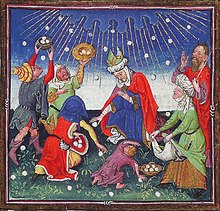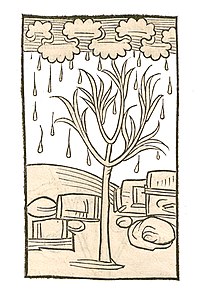Manna
Manna (Hebrew: מָן, romanized: mān, Greek: μάννα; Arabic: اَلْمَنُّ), sometimes or archaically spelled mana, is described in the Bible and the Quran as an edible substance that God bestowed upon the Israelites while they were wandering the desert during the 40-year period that followed the Exodus and preceded the conquest of Canaan.
[9] It is narrated in Sahih Muslim that Muhammad said: "Truffles are part of the 'manna' which God sent to the people of Israel through Moses, and its juice is a medicine for the eye.
[12] In the environment of a desert, such honeydew rapidly dries due to evaporation of its water content, becoming a sticky solid, and later turning whitish, yellowish, or brownish.
[13] At the turn of the twentieth century, Arabs of the Sinai Peninsula were selling this substance as man es-simma من السما, roughly meaning "heavenly manna".
[18] Some scholars have proposed that manna is cognate with the Egyptian term mennu (mnw), which designated a substance that figured in offerings; a white aromatic plant that smelled of antiu (possibly myrrh).
[19][20] Other researchers have believed manna to be a form of lichen – a plant-like colony that often has a low mass per unit volume density and a large "sail area".
In the Mishnah, manna is treated as a natural but unique substance, "created during the twilight of the sixth day of Creation",[29] and ensured to be clean, before it arrives, by the sweeping of the ground by a northern wind and subsequent rains.
[33] Modern medical science suggests the lack of defecation over such a long period of time would cause severe bowel problems, especially when other food later began to be consumed again.
[33] Many Christian vegetarians say that God had originally intended that man would not eat meat, because plants cannot move and killing them would not be sinful: manna, a non-meat substance, is used to support this theory.
[37] A midrash attributed to Rabbi Tanhuma remarks that although some were diligent enough to go into the fields to gather manna, others just lay down lazily and caught it with their outstretched hands.
[41] Despite these hints of uneven distribution, classical rabbinical literature expresses the view that manna fell in very large quantities each day.
[12][24] These critics regard this part of the manna narrative as an etiological supernature story designed to explain the origin of Shabbat observance, which in reality was probably pre-Mosaic.
[49] Form critics attribute this variation to the view that each expression of the manna ceasing derives from different lore; the "settled land" is attributed to the Priestly tradition,[24] and "Canaan's borders" to the Yahwist tradition, or to a hypothetical later redaction to synchronize the account with that of the Book of Joshua,[24] which states that the manna ceased to appear on the day after the annual Passover festival (Nisan 14), when the Israelites had reached Gilgal.
[14] Despite the eventual termination of the supply of manna, Exodus states that a small amount of it survived within an omer-sized pot or jar, which was kept facing the Testimony (possibly, adjacent to the Ark of the Covenant);[51] it indicates that God instructed this of Moses, who delegated it to Aaron.
[60] The manna ash, native to Southern Europe and Southwest Asia, produces a blue-green sap, which has medicinal value as a mild laxative,[61] demulcent, and weak expectorant.
[62] Greek and Latin physicians and encyclopedists of the 1st century AD (Dioskurides and Plinius) held manna for crumbs of Frankincense, fallen from Boswellia sacra.
[63][64] Starting with Avicenna, the physicians of the Arabian and Latin Middle Ages held that manna was a dew (ros) falling on stones and trees, and that it was sweet like honey.
In 1586 the German physician Joachim Camerarius the Younger wrote in his herbal, that manna, that was used to purge humours, was collected in Welschland from species of Fraxinus.








